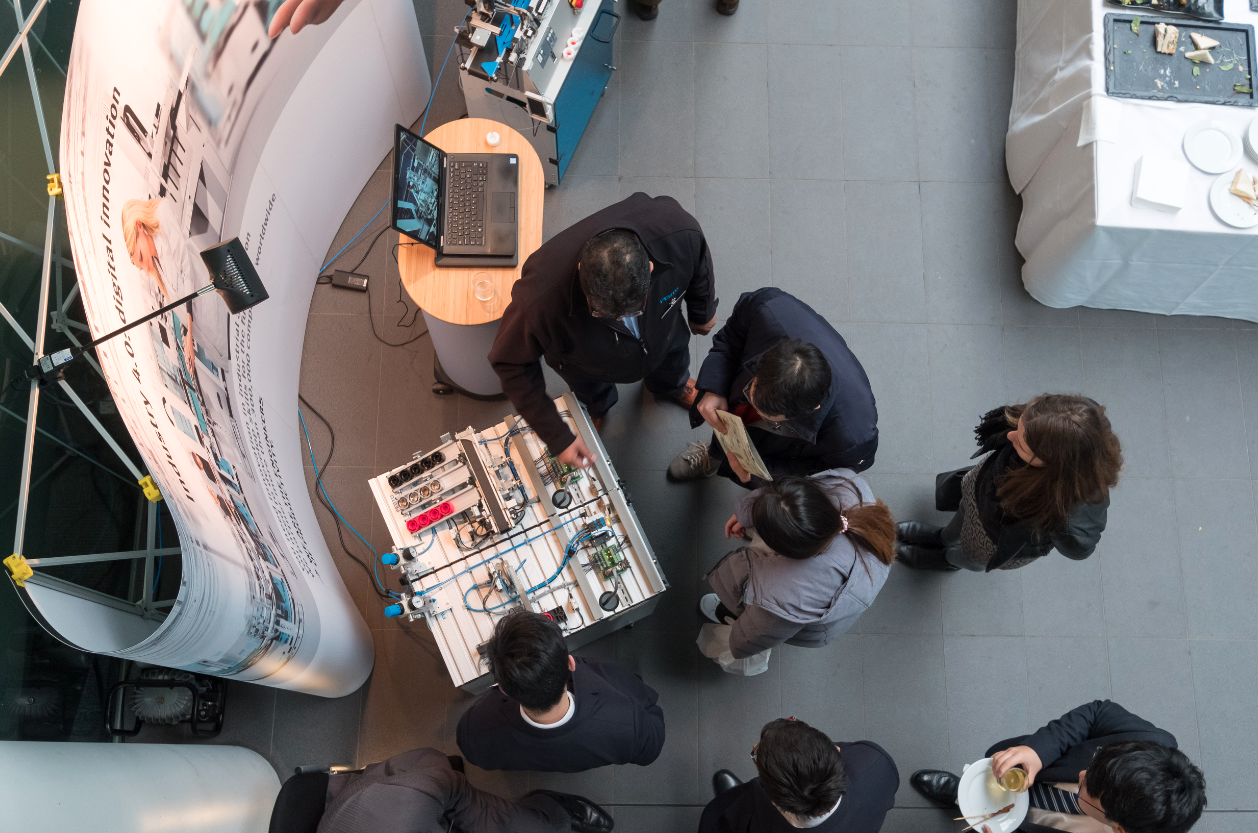Looking towards ‘Manufacturing 2075’ with Professor Mark Girolami: Part I
05/11/2018

Manufacturing engineering has always been data-centric, based on statistics captured from different forms of measurement. But the available data has been slow to arrive, limited, pedestrian.
A confluence of new technologies has led to an explosion in the capabilities of measurement and the possible data from machines, structures, processes and systems. So what was slow and static is now ‘alive’: a super-level of granularity, both in temporal and spatial data. Data-centric engineering means the information is always there to improve efficiency, performance and safety of any structure, item of machinery, or process that joins them all together.
What this means for manufacturing sector will be a key focus for Manufacturing 2075 (5 December 2018, Cranfield University).

School children enjoying the interactive learning at Manufacturing 2075: 2017
In business terms, there is the increasing importance to manufacturers of finding ways to monetise their data, to move from just providing products to a combination of products and services. A company should no longer be just a manufacturer of for example valves but an enterprise able to sell intelligence on the flow and nature of what passes through those valves.
A basis of data will allow for new technologies and materials to be introduced more effectively and safely. Like 3D printing. For all its potential there have been mostly only tentative and small-scale applications so far. In recent months, the Alan Turing Institute has been working with data from the world’s largest 3D printed structure, a 12 metre long stainless steel bridge due to be installed across one of Amsterdam’s oldest canals in 2019. The world’s largest 3D printed metal structure: a 12 metre-long stainless steel bridge. Sensors on the test bridge have provided data on how the structure has responded to a flow of people. In turn we’ve been able to create a ‘digital twin’ of the bridge and a real-time picture of how the physical bridge is performing.
With this level of analysis and quality assurance, the additive manufacture of more large-scale structures can become viable and commonplace. Civil engineering, in particular, has the potential to be transformed, allowing for more of our critical infrastructure to be manufactured cheaply and in easier to install forms. More can be provided in kit form, including entire buildings.

Register for Manufacturing 2075; 5 December 2018 at Cranfield University
The challenge will continue to be what the sector actually does in practice with all this new data. There will need to be more organisational and cultural change among manufacturers. Data-centric analytical tools, skills and practices will need to become part of every engineer’s toolbox – not just an area for the data specialists. And that will include cybersecurity (a major topic at this year’s Manufacturing 2075). More data exchange opens up more channels that can, in theory, be accessed by those with malicious intent. In this context there is going to be a real need for engineers who understand the situation holistically: the combination of clear-sighted decision-making based on an understanding of entire operations and supply chains, an ability to balance risks against benefits, to keep the business moving forward and not shrinking into itself or exposing the organisation to unnecessary threats.
Written by Professor Mark Girolami; Royal Academy of Engineering Research Chair and Chair of Statistics at the Department of Mathematics at Imperial College London, he is also Programme Director for the Alan Turing Institute-Lloyd’s Register Foundation Programme in Data-Centric Engineering.
Professor Mark Girolami will be presenting at this year’s Manufacturing 2075 conference on the 5th of December 2018.
>> Register here for this year’s Manufacturing 2075 conference <<
Categories & Tags:
Leave a comment on this post:
You might also like…
Preparing your work for Turnitin submission
Before submitting your work into Turnitin for similarity checking, if you have used referencing software then you may need to take some important steps first. Mendeley and Zotero integrate with MS Word by embedding field ...
The fast track to supercar engineering: My Cranfield journey
It’s been a dream come true to work on some of the world’s most prestigious supercars – the Aston Martin Valhalla, McLaren 750 & Artura, the GMA T.33. But every successful ...
Automotive Engineering: From student to hypercar innovation at Rimac
We sat down with recent graduate Thomas Perrin, to discuss how his year on the MSc in Automotive Engineering at Cranfield University propelled him from the lecture hall directly into the ...
What this year at Cranfield really meant to me
Every Cranfield journey is unique. In this alumni reflection, Zachea Scicluna shares what her year at Cranfield truly meant, from facing uncertainty to gaining hands-on experience in industry-backed projects. I’ve been reflecting (and delaying) ...
Preparing for assignments and exams?
Sorry! We know it seems a bit mean to mention the exams in January rather than looking forward to the break before it! However, we know many of you will be thinking about your forthcoming ...
Screening for FTSE 100 companies on Bloomberg
So you’re researching an index and need some data on its constituent companies? Bloomberg’s Equity Screening tool makes light work of this, not just for the FTSE, but for indices, exchanges and sectors worldwide. Type EQS ...






